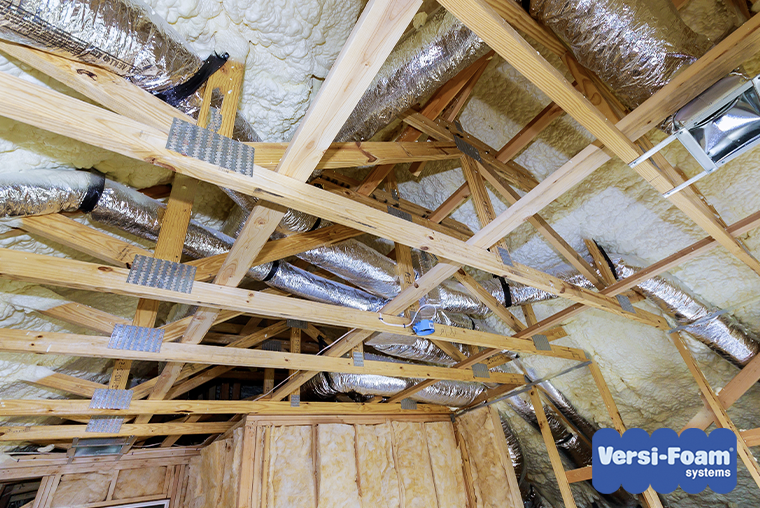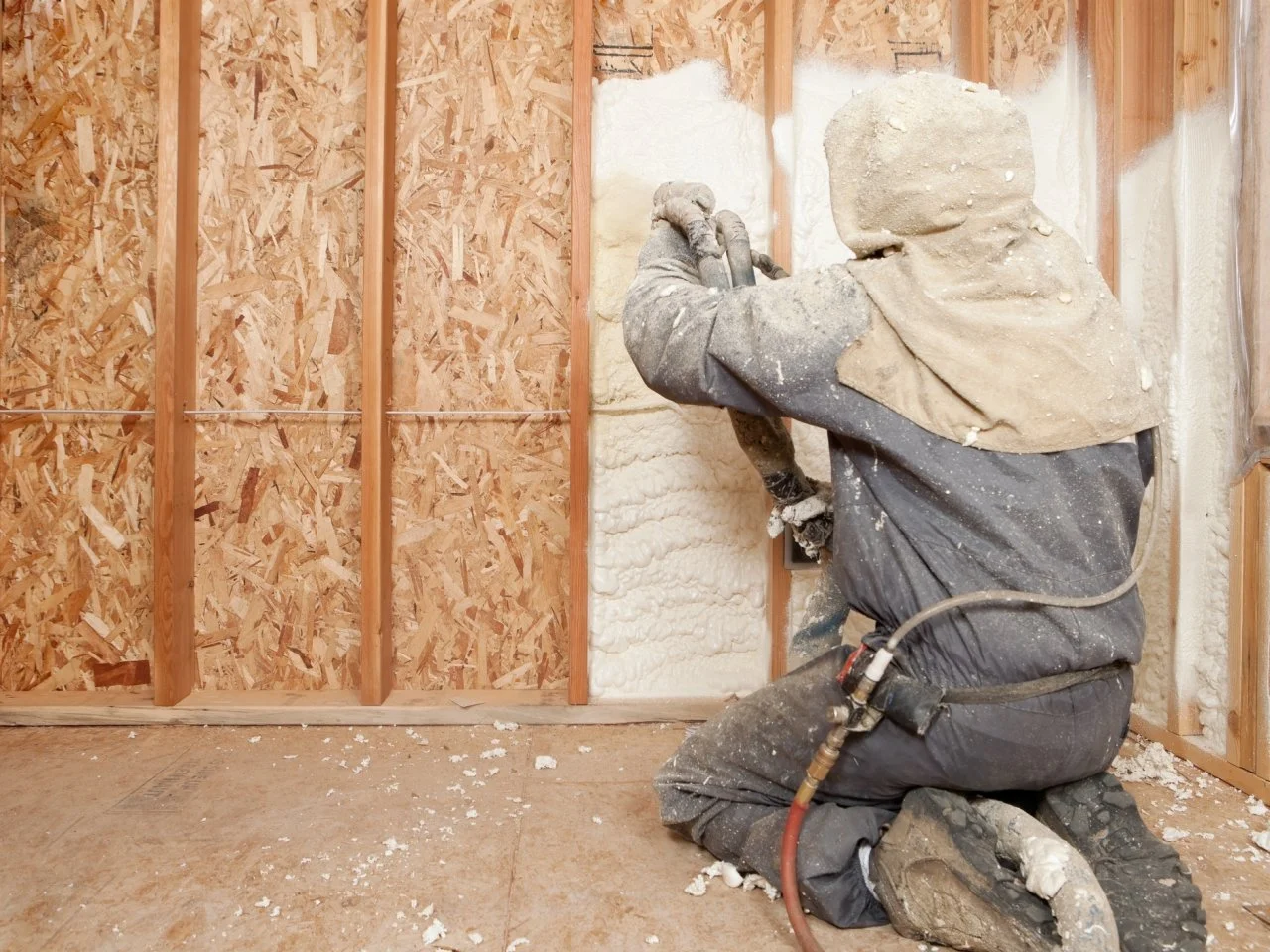Tips for Maintaining Your Spray Foam Insulation for Long-Term Performance
Tips for Maintaining Your Spray Foam Insulation for Long-Term Performance
Blog Article
Spray Foam: The Ultimate Option for Air Sealing and Insulation
Spray foam insulation has emerged as a leading service for efficient air securing and thermal insulation, supplying a special mix of properties that set it apart from traditional techniques. Understanding the complete range of its benefits, installment processes, and contrasts with various other insulation types is crucial for making notified decisions.
What Is Spray Foam?
Spray foam is a flexible insulation product that combines the concepts of air securing and thermal resistance to improve energy performance in buildings. Composed largely of polyurethane or other comparable compounds, spray foam is used as a fluid that increases upon call with surface areas, producing a solid, constant layer of insulation. This distinct building enables it to fill spaces, cracks, and voids that standard insulation materials might forget, giving an exceptional air seal.
There are two primary types of spray foam: open-cell and closed-cell. Open-cell spray foam is lighter and a lot more flexible, supplying exceptional noise absorption and a reduced R-value per inch - Spray Foam. In comparison, closed-cell spray foam is denser, offering a higher R-value, moisture resistance, and included architectural stability to developing components
The application procedure generally includes customized devices, making certain a seamless application that follows numerous substrates, consisting of concrete, timber, and metal. This flexibility makes spray foam ideal for both brand-new buildings and retrofitting existing structures. Its ability to create a closed barrier considerably adds to reducing energy consumption and boosting interior air high quality, thus making it a favored option among home builders and homeowners alike.
Benefits of Spray Foam Insulation
One of one of the most substantial benefits of spray foam insulation is its outstanding capacity to develop a continuous air obstacle, which properly lessens power loss. Unlike conventional insulation materials, spray foam broadens to load voids and cracks, ensuring that air leak is drastically lowered. This characteristic not only enhances energy effectiveness yet additionally brings about lower energy costs gradually.
Additionally, spray foam insulation supplies premium thermal resistance, contributing to a much more stable interior environment. Its high R-value per inch permits for effective insulation in confined spaces, making it perfect for attics, wall surfaces, and crawl areas. Furthermore, the moisture-resistant homes of spray foam assistance stop mold and mildew growth, advertising much healthier living conditions.
One more essential benefit of spray foam insulation is its sound-dampening top qualities (Spray Foam). It properly decreases sound transmission between areas, developing a quieter and more comfortable home atmosphere. The longevity of spray foam also stands out, as it does not droop or settle gradually, preserving its performance throughout its life expectancy
Just How Spray Foam Works
Recognizing exactly how spray foam insulation functions is necessary for appreciating its efficiency in air securing and thermal resistance. Spray foam insulation consists of 2 key elements: isocyanate and polyol material. When these components are blended, they undertake a chain reaction that creates the material to broaden swiftly, creating a thick foam that loads dental caries, voids, and cracks.
As the foam expands, it abides by surface areas, creating an impermeable seal that considerably minimizes air infiltration. This particular makes spray foam insulation very reliable at preventing drafts and wetness penetration, which can cause power loss and damages with time. Additionally, the closed-cell variant of spray foam provides remarkable thermal resistance as a result of its inflexible framework, effectively minimizing heat transfer.
The distinct properties of spray foam allow it to adapt irregular surfaces, ensuring comprehensive coverage and a seamless obstacle. As an outcome, spray foam insulation not just boosts power performance however likewise adds to improved indoor air quality by lowering the buildup of irritants and contaminants. Ultimately, understanding the technicians behind spray foam emphasizes its function as a remarkable option for insulation and air sealing in both residential and commercial applications.
Installation Refine Introduction

Prior to installment, the space needs to be Visit Your URL adequately cleaned up and prepped, making sure that surface areas are totally free from dust, wetness, and particles. This action is critical because pollutants can jeopardize bond and total efficiency. As soon as the location is prepared, the application entails blending both parts of the spray foam, which increases upon contact and fills gaps efficiently.
Trained experts must carry out the setup, making use of customized tools to make certain consistent insurance coverage and optimum thickness. Security safety measures, including wearing protective equipment and making certain correct air flow, are vital during this process. After application, the foam generally cures quickly, creating a strong obstacle that improves energy efficiency.
Contrasting Spray Foam to Typical Insulation
When examining insulation options, spray foam insulation stands out in contrast to conventional products such as fiberglass and cellulose. Unlike fiberglass and cellulose, which can enable air seepage, spray foam broadens upon application, filling up spaces and crevices to produce an airtight seal.
Additionally, spray foam offers a higher R-value per inch than conventional insulation types, providing even more effective thermal resistance in a thinner profile. This particular is particularly useful in areas with minimal tooth cavity deepness. Spray foam is immune to moisture and mold development, which can be a substantial problem with cellulose and fiberglass, particularly in humid settings.
Nonetheless, spray foam insulation generally carries a greater in advance expense than its standard equivalents. Homeowners must consider this initial investment versus long-term energy cost savings and performance advantages. Inevitably, while both insulation types offer their purpose, spray foam arises as an advanced solution for modern insulation needs, especially in terms of air securing and thermal performance.

Verdict
In summary, spray foam insulation represents a highly reliable service for accomplishing optimum air sealing and thermal resistance. Its distinct homes, including dampness resistance and audio dampening, make it suitable for various applications in both brand-new buildings and retrofitting jobs (Spray Foam). Although the initial expenses might be higher contrasted to standard insulation products, the long-term benefits, such as substantial energy savings and improved indoor air high quality, justify the investment and emphasize its worth in modern-day building techniques.
Spray foam insulation has actually arised as a leading option for effective air sealing and thermal insulation, offering a special mix of residential properties that set it apart from conventional techniques.Spray foam is a functional insulation material that integrates visit this web-site the concepts of air securing and thermal resistance to enhance energy performance in structures.When evaluating insulation choices, spray foam insulation stands out in comparison to typical materials such as fiberglass and cellulose. Eventually, while both insulation types serve their objective, spray foam arises as an extra advanced service for modern-day insulation needs, specifically in terms of air securing and thermal performance.
In summary, spray foam insulation stands for a very effective option for achieving optimal air securing and thermal resistance.
Report this page